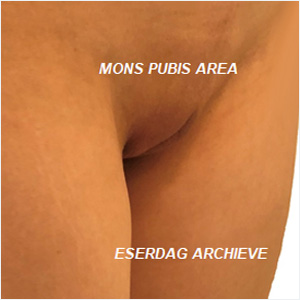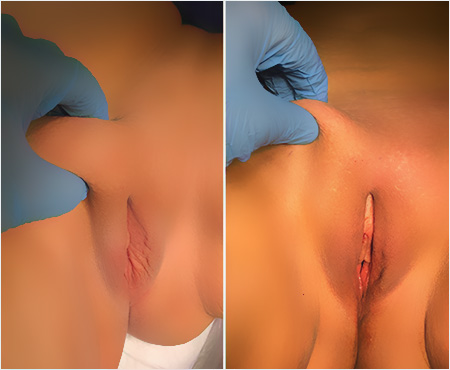Monsplasty in Turkey, Istanbul, Ankara
In recent years, the demand for female genital aesthetics has been rapidly increasing in parallel with the increase in all other aesthetic and anti-aging procedures. Monsplasty operations have also huge demand form Turkey and Europe. In our clinics in Istanbul, Ankara, and Izmir, we witness many patients tend to have monsplasty procedure, with the increasing numbers year by year.
Procedures performed as a result of women’s self-awareness, which are intended for the elimination of deformities and thickness of the area called ‘Mons pubis’ (Venus region) between the lower abdomen and the labia majora is known as ‘mons pubis reduction’ or ‘monsplasty’.
It is also known under a variety of other names including pubis aesthetics, ‘venus aesthetics’, ‘venus area aesthetics’, ‘lower abdomen aesthetics’, ‘mons reduction’, ‘mons pubis reduction’, ‘intimate aesthetics' etc.
Different forms epilation applied to this region such as ‘Hollywood wax’ or ‘Brazilian wax’ which have been in great demand especially in recent years are the other indicators of the interest in the mons pubis.
Where is the location of the mons pubis?

Mons Pubis is also called ‘Mons veneris’, ‘Venus hill ’ or ‘bikini zone’. It is anatomically the triangular section located on the anterior part of the pubic bone. It is the area covered with hairy skin extending from the lower abdomen to the labia majora, which has underlying fat tissue.
How does mons pubis change? Why does fat accumulation occurs there?
Fat and hairy skin are the two basic tissues that constitutes the mons pubis, and both of these change over time. The amount of adipose tissue covering the base of the mons pubis increases with puberty and weight gain, and decreases during the menopausal period. Also the amount of the hairs on it decreases as a result of the menopause.
Fat accumulation in this area may continue in women who lose weight after rapid weight gain. This is because even if weight loss from some parts of the body is achieved, it is difficult to lose regional fat.
The mons pubis area is one of such areas. On the other hand, especially in recent years, the need for monsplasty has increased as a result of the increase in bariatric surgeries and abdominoplasty operations.
What kind of complaints does fat accumulation in the mons pubis cause?
Increased adipose tissue in the mons pubis is called ‘mons pubis hypertrophy’. Mons pubis hypertrophy can lead to different complaints in people. The most common complaints among them include:
- The protruding, curved appearance of the area while wearing bikini and tights,
- Dissatisfaction with the aesthetic appearance,
- Loss of self-confidence,
- Problems such as embarrassment towards the sexual partner.
What is monsplasty? Mons pubis reduction
The reduction procedure involving the removal of the excess subcutaneous fat tissue in the pubis area is called ‘monsplasty’ or ‘mons pubis reduction’. With the procedure, the excess fat tissue is reduced by using the lipoaspiration (simple manual liposuction) or energy-based liposuction methods. Fat removal alone cannot be adequate in some cases, where a certain amount of skin tissue may need to be removed as well.

How is the procedure performed?
The procedure is usually The procedure can be performed under local anesthesia, by inserting cannulas (thin tubes) into the mons pubis area through millimetric incisions made at the both sides (from the cesarean suture area). Usually 80-200 cc of fat can be aspirated into the negative pressure injector. The procedure takes 30 minutes on average. In case of excessive fat removal, skin sagging may develop, so such mistakes should be avoided.
Fats harvested during mons pubis reduction can also be injected into different regions...
Fat tissue removed during mons reduction can be put through certain processes and then can be applied to the labia majora to eliminate collapsed scars caused by previous surgical operations, and even to the anterior vaginal wall to increase sexual pleasure and facilitate orgasm.
After thinned, the adipose tissue is mixed with PRP, if necessary, and then is transferred to the required areas through a thin cannula. Moreover, SVF and stem cells obtained by processing the removed fat can be used for regenerative purposes in different regions.
What is a mini abdominoplasty? (Mini Tummy Tuck)
The procedure intended to reduce the mons area by removing the excess skin and subcutaneous tissue from there is called ‘mini abdominoplasty' or 'mini tummy tuck'. The same surgical operation can also involve the elimination of unsightly surgical scars caused by to cesarean section ('scar revision').
Surgical procedures in the form of ‘mini abdominoplasty’ allow for the removal of scar tissues and excess tissues with wedge-shaped excisions. In some patients, mons pubis area can be slimmed during abdominoplasty operations as well.
Does monsplasty involve any risk?
The procedure does not cause loss of sexual sensation. It involves the general risks that can be seen in any surgical operation, such as pain, bleeding, infection, dimple formation in the tissue etc. In addition, if the mons pubis is lifted excessively, the labia minora, labia minora and clitoris can migrate upwards, as well.
This can also be observed after abdominoplasty operations. Therefore, excessive stretching should be avoided. On the other hand, excessive amount of fat removal through lipoaspiration during monsplasty may cause skin sagging in patients. In such a case, a surgical revision may be needed.
Success of the Procedure
According to our own statistics, the success of the procedure and patient’s satisfaction levels are quite high.
After Monsplasty
The fat removal procedure for mons pubis hypertrophy is usually daily and does not require hospitalization. Patients can usually be discharged 4-5 hours after the operation. After the procedure, tight dressing or bandage applied to the area where fat was removed, staying for 48 hours, using painkillers and antibiotics are among the recommendations for discharge.
Bleeding control is important especially in the first day.






